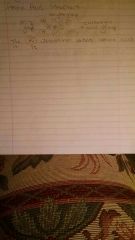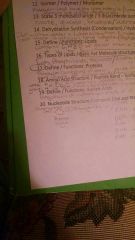![]()
![]()
![]()
Use LEFT and RIGHT arrow keys to navigate between flashcards;
Use UP and DOWN arrow keys to flip the card;
H to show hint;
A reads text to speech;
29 Cards in this Set
- Front
- Back
|
Covalent Bond |
The sharing of electrons between atoms |
|
|
Ionic Bond |
The attraction and bonding of two oppositely charged ions |
|
|
Ion |
Charged Molecule formed by gaining or losing electrons |
|
|
Acidic / Basic / Neutral Solutions |
Acidic: A higher concentration of H+ ions than OH- ions. Basic: A higher concentration of OH- ions than H+ ions. Nuetral: Equal amounts of H+ and OH- ions. |
|
|
Water Properties |
Hydrogen Bonding: water molecules tend to stick together (cohesion) Solvency / Chemical Reactivity: water interacts with many other molecules and is a universal solvent Temperature Moderation: water has a high specific heat Water Density: Ice is less dense than water - it floats in water |
|
|
Organic |
Has a carbon skeleton and contains hydrogen |
|
|
Inorganic |
All molecules without carbon |
|
|
6 most common elements in living things |
Nitrogen Carbon Hydrogen Oxygen Phosphorous Sulfer |
|
|
Carbohydrates |
Define: Molecules composed of carbon, hydrogen, and oxygen with a 2:1 ratio of hydrogen to oxygen Function: Provide energy or structural support |
|
|
Monosaccharides |
One sugar molecule Pentose: 5 carbon sugar Ex. Ribose, Deoxyribose (used in RNA and DNA) Hexose: 6 carbon sugar Ex. Fructose (sweetest), Glucose, Galactose |
|
|
Disaccharides |
Two sugars bonded by dehydration synthesis Sucrose: Glucose + Fructose (table sugar) Maltose: Glucose + Glucose (malt sugar) Lactose: Glucose + Galactose (milk sugar) |
|
|
Polysaccharides |
Many sugar molecules bonded by dehydration synthesis (complex) Starch: Chains of Glucose in a spiral. Energy storage in plants Glycogen: Branched Chains of Glucose (more complex than starch because there are more bonds). Energy storage in animals. Cellulose: (Fiber) long chains in pleated sheet. Used in cell walls (structural) not soluble in water, we can't digest it |
|
|
Isomer |
Molecules with same molecular formulas but differ structurally |
|
|
Polymer |
Long chain of monomers |
|
|
Monomer |
Small organic molecules |
|
|
Dehydration Synthesis |
(Condensation) When a water molecule is taken from two molecules they form a bond |
|
|
Hydrolysis |
Adding water breaks molecule into two. Used in digestion |
|
|
Lipids |
Define: Contains carbon, hydrogen and oxygen with greater than a 2:1 ratio of hydrogen to oxygen Functions: Energy storage, water proof, cell membrane, hormones Types: Fats, phospholipids, steroids |
|
|
Fats |
Fats / oils: 3 fatty acid units + 1 glycerol molecule, long term energy storage in plants and animals Waxes: Water proofing, structure |
|
|
Phospholipids |
Used in cell membrane. 2 fatty acids + 1 glycerol + a polar group. Head: (polar group and glycerol) polar, water soluble, hydrophilic Tail: (fatty acids) nonpolar, insoluble in water, hydrophobic |
|
|
Steroids |
(Hormones) regulates chemical reactions 4 rings of carbon Cholesterol: membrane of animal cells, synthesizes other steroids Male / female sex hormones: regulates salt levels and bile that assist in fat digestion (m - testosterone, f - estrogen) |
|
|
Saturated |
Bad for you body found in animal fat Lipids with the maximum amount of hydrogen atoms |
|
|
Unsaturated |
Good for your body, most oils. More double bonds between carbon and fewer hydrogen. |
|
|
Proteins |
Define: Molecules composed of one or more chains of amino acids Functions: Guide chemical reactions, structural, energy storage, transport, cell movement, antibodies, poison |
|
|
4 levels of protein stucture |
Primary: the sequence of amino acids. Secondary: protein chains in a helix or pleated sheet Tertiary: bending into 3-D figures Quaternary: layering of 2 or more tertiary figures |
|
|
Peptide Bond |
Carbon to nitrogen bond between two amino acids. |
|
|
Amino acid structure |

|
|
|
Nucleic Acids |
Define: Long chains of nucleotides made of carbon, hydrogen, oxygen, nitrogen, and phosphorus Functions: Hereditary material, direct the production of proteins |
|
|
Nucleotide Stucture |

|

